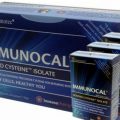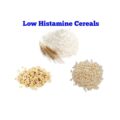For over days my legs had been itching at exactly the point it does when I take sulfur-containing drugs but this time I had not taken any medication. I was confused because the itching persisted and the more I scratched the area the more I feel the skin about to peel from abrasions.
Then I began a little investigation of my own and it turned out that my yogurt contained Acesulfame potassium (E950) as a sweetener. Acesulfame potassium, 200 times sweeter than sugar, is an artificial sweetener used in food and beverage to replace sugar by providing a sweet taste with no calories and zero glycemic indexes, which may be helpful in controlling weight & obesity and benefits diabetes. The European food additive number is E950. You might also see this ingredient listed as Ace-K or Acesulfame K on the food label.
Ace-K is one of eight approved high-intensity sweeteners in the United States by the FDA. The other seven are saccharin (E954), aspartame (E951), sucralose (E955), neotame (E961), advantame (E969), steviol glycosides (E960), and Luo Han Guo fruit extracts. Ace-K is commercially made from the chemical reactions among sulfamic acid, diketene, triethylamine, acetic acid, sulfur trioxide, and potassium hydroxide.
However, the ingredient used in making this sweetener contains sulfur, a recognized allergen. In 2006, controversies say that it may cause cancer and more studies should be performed if it is safe. Unlike some of the potential triggers in diets, such as lactose or gluten, sulfur is an essential mineral your body needs to perform certain functions, possibly leading some to think it’s not possible to be intolerant to it.
Before we dive into the science behind sulfur intolerance, let’s take a moment for some definitions so we’re on the same page. There are several sulfur-containing substances to which people may have an allergy, intolerance, or another type of negative reaction:
- Sulfide—a class of minerals that have sulfide, or two sulfide ions, as the major anion.
- Sulfate—a salt that is the reaction between sulfuric acid and another chemical; synthetic sulfates are found in sodium lauryl sulfate and sodium Laureth sulfate, which are often used in cleaning and personal care products.
- Sulfite—commonly used in food processing for enhancing food or preserving it, compounds in this class contain a sulfite ion and are salts from sulfurous acid.
- Sulfa drugs—sulfa may sound like sulfur, but this ingredient found in certain antibiotics and medications is not the same as sulfur or sulfites.
In this blog, we are going to focus on intolerance to sulfur as it is presented naturally in food and used in the body, not one of the additive compounds listed above.
Roles of Sulfur in the Body
One major place you will find sulfur in the human body is sulfur-containing amino acids, specifically homocysteine, taurine, methionine, and cysteine. These amino acids are used in many key roles in the body, including your immune system, oxidation reactions, metabolism, and protein structures, although methionine and cysteine are the only two used in proteins. Methionine acts as a precursor to SAM (S-adenosylmethionine), while cysteine is a precursor to glutathione and taurine. SAM is an antioxidant, and it is the methyl donor for most methyltransferases that make changes to DNA, RNA, and proteins. Thus, sulfur plays a role in the cell’s methylation processes. We’ll discuss this more shortly.
Methionine is considered an essential amino acid, which means you cannot synthesize it yourself, while cysteine is a conditionally essential amino acid, which means in some situations, your need for the amino acid may be more than your ability to create it. Sulfur amino acids are also resistant to oxidation because they are sensitive to reactive oxygen species (ROS) and the oxidation is reversible. This means they can combine with any ROS (the potentially destructive free radicals) to reduce the potential for damage. Cysteine likewise has an antioxidant capacity and is essential for the production of glutathione and taurine.
Sulfur from sulfur amino acids, namely cysteine, is also incorporated into tRNAs known as tRNA thiolation. Any imbalances or alterations in tRNA thiolation could lead to downstream problems, such as insulin signaling impairment. There are also many sulfur-containing cofactors that play a role in many different biochemical reactions in the body. One type of these is iron-sulfur clusters, which are believed to be some of the oldest cofactors and are found in almost all living organisms. These are used in a variety of functions, including in the electron transfer chain and in DNA repair. These metalloproteins may also play a role in maintaining copper homeostasis since they act as a target for copper to bind with.
Sulfur is not found through just amino acids; sulforaphanes are compounds found in cruciferous vegetables and other foods. These compounds provide protective benefits, including antioxidant and anti-inflammatory and inducer of Nrf2, especially against neurological disorders.
Potential Downsides
Despite the importance of sulfur amino acids, high levels have been linked with obesity and obesity-related illnesses such as diabetes. This may be due to the link between higher meat consumption in those with higher levels of SAA.
Sulfur amino acids may also play a role in atherosclerosis and lipid metabolism. In a 2017 mice study, researchers found the metabolism of sulfur amino acids and lipid metabolism in mice consuming an atherogenic diet (one that predisposes them to atherosclerosis). They found evidence that there was an increase in the metabolism of SAA in the heart which also increased the oxidative stress in the heart. An imbalance of SAA may also contribute to fatty liver disease. The connection between sulfur amino acids and lipid metabolism may be an influence on the expression of SCD-1, an enzyme that plays a role in the synthesis of monounsaturated fatty acids found mainly in adipose tissue and the liver.
Sulfur in Detoxification
Sulfur and sulfur-containing amino acids play an important role in phase II detoxification. During this stage, also known as conjugation, molecules combine with the molecule that is the result of the initial phase of detoxification. Sulfur is used in sulfation, glucuronidation, and glutathione-S-transferase, three of the possible routes for conjugation. Methionine is used in methyltransferase and methylation, another possible route. Thus, if you have a deficiency in sulfur, then you may not have the necessary capacity to handle any potential toxins, medications, or metabolites in your system that require this process prior to elimination.
Methionine and cysteine play a role in glutathione synthesis and recycling. Glutathione is the body’s major intercellular antioxidant, which not only counters oxidative stress and is necessary to reduce inflammation and keep your immune system strong, but it is also a part of the detoxification process. Cysteine is a precursor of glutathione, while methionine can synthesize glutathione through the transsulfuration pathway, which can also use homocysteine to create glutathione.
With so many different functions in the body, one may think that you want to consume as much sulfur as possible. However, as with many nutrients, there is a particular balance to maintain, and it may be possible to have a negative reaction when you consume more sulfur than your body can handle, as we will discuss.
So Why is Sulphur Causing Issues for People Like me?
If our bodies were meant to have sulfur and need them for the above elements and functions, then how can so many people have issues with sulfur? Is it really the sulfur causing the problem, or is it something else? Let’s see what the literature says.
But first, a brief look at the symptoms most commonly associated with sulfur intolerance when you search through the information online, since there are not many studies looking directly at sulfur intolerance:
- Asthma
- Brain Fog
- Fatigue
- Flushing
- Gas and Bloating
- Headaches
- Hives
- Itchiness
- Nausea
Possible Causes of Sulfur Intolerance
As of yet, there is limited research into sulfur intolerance or allergy specifically. However, there are potential underlying issues that could affect one’s ability to tolerate sulfur-rich foods, which may present as something similar to intolerance to sulfur-containing foods.
Some of the current hypotheses about possible causes include:
- SIBO and/or dysbiosis
- Methylation issues
- Issues in the metabolism of sulfur amino acids
- Problems with detoxification
- Polymorphisms
SIBO and Dysbiosis
Certain bacteria convert sulfur into hydrogen sulfide gas, which is what causes gas to smell like rotten eggs. This gas can be beneficial and protective, but like many things, excess levels can become toxic. When you have excess growth of these hydrogen sulfide-producing bacteria, it can lead to SIBO and/or dysbiosis, creating issues such as inflammatory bowel disease. Thus, some of the symptoms and issues may not come directly from consuming sulfur-rich foods but instead stem from something going on in your gut that makes it more difficult to process the food—or the food may lead to a higher amount of hydrogen sulfide gas.
There are currently no testing options available for hydrogen sulfide SIBO, but you can take a stool test that will tell you whether you have this type of dysbiosis. Treatment for sulfur-associated SIBO and/or dysbiosis would be similar to that of treating other types of SIBO or dysbiosis, although you may find that consuming a low-sulfur diet helps. Talk to your doctor or practitioner about a solution if you suspect some type of dysbiosis to be the cause of your sulfur intolerance.
Methylation Problems
There’s a good chance you have heard the term methylation, but you may not know exactly what it means. Basically, this is a process that attaches a methyl group (a molecule of a single carbon and three hydrogens) to another molecule. Demethylation removes a methyl group. This plays an important role in many body functions, including production and recycling of glutathione, detoxification, inflammation, DNA repair, gene expression, neurotransmitter synthesis, energy production, antioxidant capacity, free radical protection, and the immune system to name a few. Any changes in the methylation cycle, including a reduction of the methyl groups, can disrupt any of the processes, leading to symptoms or disease. For example, there is a link to poor methylation and autoimmune diseases, such as multiple sclerosis and psoriasis.
A key part of methylation is the methionine-homocysteine cycle, which creates SAM for the methyl group donation. When the methionine-homocysteine cycle leads to an excess of homocysteine, usually due to a deficiency in the cofactors needed to re-methylate homocysteine such as folate and vitamin B12, problems may arise. Most of the high-homocysteine research points to potential associations between high homocysteine levels and cognitive dysfunction, metabolic syndrome, and cardiovascular disease. These are complex chronic illnesses that take a long time to develop and which have many different factors contributing to their development, rather than symptoms that appear after consuming sulfur-rich foods. However, some studies have found that high homocysteine levels directly damage endothelial cells. It can also contribute to oxidative stress and inflammation.
Could a higher amount of homocysteine or another metabolite of sulfur-rich amino acids contribute to temporary symptoms as well? The research so far has not identified any acute symptoms of high homocysteine. However, high homocysteine may trigger acute changes that over time develop into a chronic disease, especially in sensitive individuals. Although there are many reasons you may have a higher than necessary level of homocysteine, consuming more methionine than what you can handle in your methylation cycle may contribute to problems.
Roughly 20% of the methionine you consume is processed in the gut, which not only can fuel sulfur-consuming bacteria as discussed above, but it can also create excess levels of homocysteine in the GI tract that can act locally. This may trigger an inflammatory response, contributing to symptoms. It also can reduce the levels of glutathione, which could affect the gut’s antioxidant capacity and thus increase the risk of the development of diseases, such as inflammatory bowel disease.
One option for the breakdown of histamine is methylation requiring SAMe. If there are issues with methylation, you may end up with an imbalance of histamine, causing itchiness, hives, and the more traditional allergenic symptoms.
Because methylation and glutathione play important roles in the body’s detoxification process, when there is dysfunction in the process, it can reduce your ability to detoxify from heavy metals and other toxins. This, in turn, may also contribute to symptoms and chronic diseases.
Thus, any issues with the methionine and/or cysteine pathways, including excess consumption of the sulfur amino acids, may contribute to one or more of these issues, leading to symptoms including those listed above associated with sulfur intolerance.
Polymorphisms
You’ve probably heard a lot about the MTHFR genetic polymorphisms and their impact on methylation. This gene plays a role in the ability to convert homocysteine back into methionine to then have a methyl group for the methylation pathways. As discussed, imbalances in this cycle may contribute to problems with sulfur metabolism and symptoms of dysfunction.
However, there is another gene more directly associated with sulfur intolerance: cystathionine beta-synthase or CBS. This gene regulates an enzyme that regulates the sulfur movement from methionine to cysteine, which is the initial step of the transsulfuration pathway, which ultimately converts cysteine into taurine or glutathione. Specifically, it converts homocysteine into cystathionine by removing the sulfur-containing amino acids. Polymorphisms in this gene have the potential to interrupt this cycle, leading to downstream problems.
Conclusion
Anecdotally, there are many individuals who do better when consuming a low-sulfur diet, possibly due to the underlying causes mentioned above. Thus, sulfur intolerance most likely is not due to the sulfur itself per se, but an inability to keep the right sulfur balance, which may throw off homeostasis and disrupt processes further downstream.
There are imbalances in the body that might be exacerbated or triggered by consuming high levels of sulfur-rich food and be relieved through a reduction in sulfur consumption. Does this qualify as sulfur intolerance? Possibly not in the same way that gluten intolerance or lactose intolerance are primary intolerances triggered specifically by the foods themselves.
However, there seems to be a balance required for sulfur, so it may be that a person could have an underlying reason to react negatively toward sulfur-containing foods, making it a secondary problem as opposed to a primary issue. As more research is conducted in this area, we may find more evidence for primary sulfur intolerance.
What to Do If You Suspect You Have Sulfur Intolerance
One of the main ways to help a suspected sulfur intolerance is to consume a diet low in sulfur. A trial low-sulfur diet for a few weeks may shine some light on whether the problems you are experiencing are due to sulfur-containing foods or something else. Then, you can start to treat any potential underlying reasons for the issue, such as dysbiosis or methylation issues.
Additionally, certain supplements may help you to process sulfur to reduce or eliminate the symptoms. One of the best to take is molybdenum. Molybdenum plays a role in sulfite oxidase, which is used in the final step of the degradation of cysteine. Supplements shown to support the methylation process include choline and the B-vitamins, especially folate and vitamin B12.
It is best to do this under the guidance of a healthcare practitioner. Taking supplements, as well as changes to your diet, is always best done under the care of an expert, but even more so when dealing with something like sulfur, which is found in many nutrient-dense foods. An expert can help you create a well-balanced diet that is also lower in sulfur foods. Your practitioner can also help you to work on the underlying issues as well as supplement with additional things that may help you better process sulfur. SEE: Download Free Books On Food Chemistry Pdf





